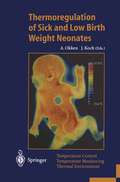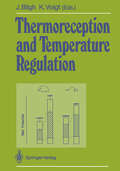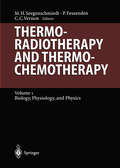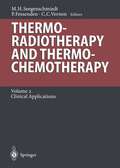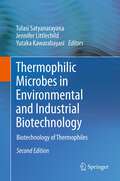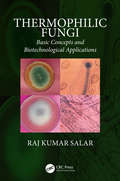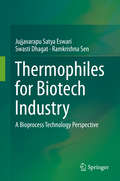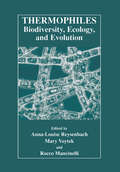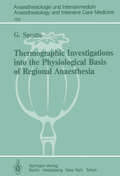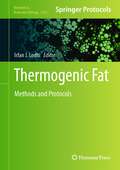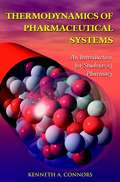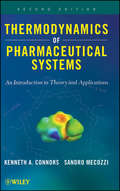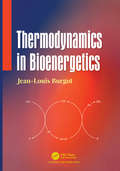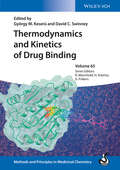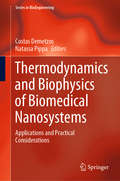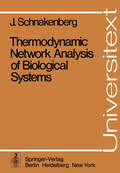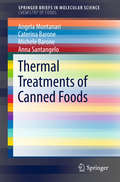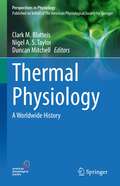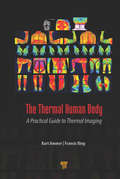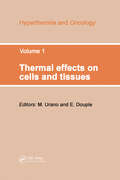- Table View
- List View
Thermoregulation of Sick and Low Birth Weight Neonates: Temperature Control. Temperature Monitoring. Thermal Environment
by Albert Okken Jochim KochIn this book, the editors have succeeded in bringing together many renowned authors in the field. They discuss the physical principles of heat transfer in various heating devices used in neonatal care for temperature distribution throughout the body, such as incubators, open radiant warmers, and heated mattresses, as well as the significance of simultaneously monitoring core and periphal temperature. Alongside a treatment of extreme thermal conditions, contributions also pinpoint the optimal thermal environment. An invaluable aid for all those working in the field of neonatal care, including doctors, scientists, students, and nurses.
Thermoreception and Temperature Regulation
by H. A. Braun K. Brück G. HeldmaierAs indicated in the Preface, the contributions to this volume are based upon the papers presented at the symposium on Thermoreceptors and Temperature Regula tion held in July 1988 at the Institute of Physiology of the University of Marburg (Federal Republic of Germany) to celebrate and commemorate the life and achievements of HERBERT HENSEL, who directed that Institute from 1955 until his death in 1983, and whose most notable and significant contributions to thermo physiology were in the areas of the properties and characteristics of thermo sensors, mammalian thermoregulation more generally, and the psychophysiology of ther mal sensation. All the papers in this volume deal, to a greater or lesser extent, with these discernibly different but closely allied aspects of mammalian physiology. The editors have sought to achieve cohesion, flow, and balance both in the contributed articles and in their order of presentation, without either large gaps or redundancies in the coverage of the recent advances in the understanding of thermoreceptors and thermoregulation. At the same time we have sought to avoid such a degree of editorial control as to destroy the individuality of the contributions, and the judgements upon which they were based. We have also sought to look both backwards and forwards, and to include some legitimate extension of the con sideration of thermosensitivity and thermoregulation into such areas as climatic adaptation and fever. Hence the "greater or lesser" of the closeness of this series of papers to HERBERT HENSEL'S scientific interests.
Thermoradiotherapy and Thermochemotherapy: Biology, Physiology, Physics (Medical Radiology)
by J. C. Bolomey P. Burgman I. B. Choi J. Crezee O. Dahl M. W. Dewhirst C. J. Diederich R. Felix K. Hynynen D. K. Kelleher A.W.T. Konings J.J.W. Lagendijk D. Le Bihan E. R. Lee G. C. Li S. Mizushina J. Mooibroeck J. Nadobny B. S. Nah A. Nussenzweig R. Olmi J. L. Osborn K. D. Paulsen D. M. Prescott D. I. Roos S. K. Sahu C. J. Schneider M. Seebass M. H. Seegenschmiedt C. W. Song P. R. Stauffer C. Streffer J.D.P. van Dijk G.C. van Roon P. W. Vaupel C. C. Vernon A. Visser F. M. Waterman P. WustHyperthermia has been found to be of great benefit in combination with radiation therapy or chemotherapy in the management of patients with difficult and com plicated tumor problems. It has been demonstrated to increase the efficacy, of ionising radiation when used locally but also has been of help in combination with systemic chemotherapy where hyperthermia is carried out to the total body. Problems remain with regard to maximizing the effects of hyperthermia as in fluenced by blood flow, heat loss, etc. The present volume defines the current knowledge relative to hyperthermia with radiation therapy and/or chemotherapy, giving a comprehensive overview of its use in cancer management. Philadelphia/Hamburg, June 1995 L.W. BRADY H.-P. HEILMANN Preface In an attempt to overcome tumor resistance, hypoxia, or unfavorable tumor condi tions, oncological research has come to focus on gene therapy, immunotherapy, new cytotoxic agents, and increasingly sophisticated radiotherapy. Radiation research has been directed towards heavy particle therapy and modification of the radiation response by either protecting or sensitizing agents. Improved dose localization using rotational or conformal strategies has also been implemented. Recently, changes in radiation fractionation schedules have shown promise of better results. Hyperthermia in cancer therapy can be viewed similarly as another means to increase the sensitivity of tumors to radio- and chemotherapy.
Thermoradiotherapy and Thermochemotherapy: Volume 2: Clinical Applications (Medical Radiology)
by L. W. Brady H. P. HeilmannHyperthermia has been found to be of great benefit in combination with radiation therapy or chemotherapy in the management of patients with difficult and com plicated tumor problems. It has been demonstrated to increase the efficacy of ionizing radiation when used locally but also has been of help in combination with systemic chemotherapy where hyperthermia is carried out to the total body. Triple modality (thermo-chemo-radiotherapy) or other treatment combinations have not been fully evaluated and may demonstrate extended clinical applications in the future. Problems remain with regard to maximizing the effects of hyperthermia as they are influenced by a variety of external and intrinsic factors including bloodflow, microenvironment etc. While the previous volume has summarized more theoretical aspects of hyper thermia, i.e. biology, physiology and physics, the present volume compiles the current knowledge relative to the clinical applications of hyperthermia in combina tion with radiation therapy and/or chemotherapy, providing a comprehensive over view of its use in cancer management.
Thermophilic Microbes in Environmental and Industrial Biotechnology: Biotechnology of Thermophiles
by Tulasi Satyanarayana, Jennifer Littlechild and Yutaka KawarabayasiThe existence of life at high temperatures is quiet fascinating. At elevated temperatures, only microorganisms are capable of growth and survival. Many thermophilic microbial genera have been isolated from man-made (washing machines, factory effluents, waste streams and acid mine effluents) and natural (volcanic areas, geothermal areas, terrestrial hot springs, submarine hydrothermal vents, geothermally heated oil reserves and oil wells, sun-heated litter and soils/sediments) thermal habitats throughout the world. Both culture-dependent and culture-independent approaches have been employed for understanding the diversity of microbes in hot environments. Interest in their diversity, ecology, and physiology has increased enormously during the past few decades as indicated by the deliberations in international conferences on extremophiles and thermophiles held every alternate year and papers published in journals such as Extremophiles. Thermophilic moulds and bacteria have been extensively studied in plant biomass bioconversion processes as sources of industrial enzymes and as gene donors. In the development of third generation biofuels such as bioethanol, thermophilic fungal and bacterial enzymes are of particular interest. The book is aimed at bringing together scattered up-to-date information on various aspects of thermophiles such as the diversity of thermophiles and viruses of thermophiles, their potential roles in pollution control and bioremediation, and composting.
Thermophilic Fungi: Basic Concepts and Biotechnological Applications
by Raj Kumar SalarThis book aims to fill the gap by documenting thermophilic fungi discovered over the past five decades. The chapters spans from covering basic aspects, taxonomy and classification including molecular phyologeny and biotechnological applications of thermophilic fungi.
Thermophilic Fungi: Basic Concepts and Biotechnological Applications
by Raj Kumar SalarThis book aims to fill the gap by documenting thermophilic fungi discovered over the past five decades. The chapters spans from covering basic aspects, taxonomy and classification including molecular phyologeny and biotechnological applications of thermophilic fungi.
Thermophiles for Biotech Industry: A Bioprocess Technology Perspective
by Jujjavarapu Satya Eswari Swasti Dhagat Ramkrishna SenThermophiles and hyperthermophiles exhibit great biotechnological potential, as they can be utilized in processes which require higher temperatures. This book comprehensively deals with all the aspects of thermophiles, starting from the source of these organisms to their latest applications. In addition it presents a compilation of all compounds produced by various thermophilic microorganisms. Due to their application in everyday life, the demands of enzymes that can work at higher temperature have been increasing. In order to keep pace with the increasing demand the industries have to search novel thermophiles producing their product of interest. Hence, this book will be of value for industries working on various biochemical products produced by these thermophiles as well as for scientists and research scholars working on microbiology and products derived from microorganisms.
Thermophiles: Biodiversity, Ecology, and Evolution
by RoccoMancinelli MaryVoytek Anna-LouiseReysenbachThese are indeed exciting times to be a microbiologist. With one of the buzzwords of the past decade-"Biodiversity," and microbes are reveling in the attention as they represent by far most of the biodiversity on Earth. Microbes can thrive in almost any environment where there is an exploitable energy source, and, as a result, the possible existence of microbial life elsewhere in the solar system has stimulated the imaginations of many. Extremophiles have taken center stage in these investigations, and thermophiles have taken on the lead roles. Consequently, in the past decade there has been a surge of interest and research in the Ecology, Biology, and Biotechnology of microorganisms from thermal environments. Many of the foundations of thermophile research were laid in Yellowstone National Park, primarily by the research of Professor Thomas Brock's laboratory in the late 1960s and early 1970s. The upper temperature for life was debated, the first thermophilic archeum discovered (although it was only later shown to be an archeum by ribosomal cataloging), and the extremes of light, temperature, pH on the physiology of microorga nisms were explored. Interest in thermophiles increased steadily in the 1970s, and with the discovery of deep-sea hydrothermal vents in 1977, thermophilic research began its expo nential explosion. The development of Taq polymerase in the polymerase chain reaction (peR) focused interest on the biotechnological potential of thermophilic microorganisms and on the thermal features in Yellowstone National Park.
Thermographic Investigations into the Physiological Basis of Regional Anaesthesia (Anaesthesiologie und Intensivmedizin Anaesthesiology and Intensive Care Medicine #159)
by G. SprotteThermogenic Fat: Methods and Protocols (Methods in Molecular Biology #2662)
by Irfan J. LodhiThis volume presents a broad collection of state-of-the-art methods to study the biology of thermogenic fat using in vitro cell culture and animal models. Chapters guide the readers through protocols on differentiation of human pluripotent stem cells and murine adipocyte precursors; methods for measuring mitochondrial respiration, heat generation, brown fat activation, and effects on energy metabolism in mice; and techniques for AAV-mediated gene delivery, transplantation of adipose tissue, isolation of adipose tissue immune cells and extracellular vesicles, and mass spectrometry-based profiling of brown fat lipids. Written in the format of the highly successful Methods in Molecular Biology series, each chapter includes an introduction to the topic, lists necessary materials and methods, includes tips on troubleshooting and known pitfalls, and step-by-step, readily reproducible protocols. Authoritative and cutting-edge, Thermogenic Fat: Methods and Protocols aims to be comprehensive guide for researchers in the field.
Thermodynamics of Pharmaceutical Systems: An Introduction for Students of Pharmacy
by Kenneth A. ConnorsStudies of thermodynamics often fail to demonstrate how the mathematical intricacies of the subject relate to practical laboratory applications. Thermodynamics of Pharmaceutical Systems makes these connections clear, emphasizing specific applications to pharmaceutical systems in a study created specifically for contemporary curriculums at colleges of pharmacy. Students investigating drug discovery, drug delivery, and drug action will benefit from Kenneth Connors's authoritative treatment of the fundamentals of thermodynamics as well as his attention to drug molecules and experimental considerations. An extensive appendix that reviews the mathematics needed to master the pharmacy curriculum proves an invaluable reference. Connors divides his one-of-a-kind text into three sections: Basic Thermodynamics, Thermodynamics of Physical Processes, and Thermodynamics of Chemical Processes; chapters include: * Energy and the First Law of Thermodynamics * The Entropy Concept * Phase Transformations * Solubility * Acid-Base Equilibria * Noncovalent Binding Equilibria Thermodynamics need not be a mystery nor be confined to the realm of mathematical theory. Thermodynamics of Pharmaceutical Systems introduces students of pharmacy to the profound thermodynamic applications in the laboratory while also serving as a handy resource for practicing researchers.
Thermodynamics of Pharmaceutical Systems: An introduction to Theory and Applications
by Kenneth A. Connors Sandro MecozziDesigned for pharmacy students Now updated for its Second Edition, Thermodynamics of Pharmaceutical Systems provides pharmacy students with a much-needed introduction to the mathematical intricacies of thermodynamics in relation to practical laboratory applications. Designed to meet the needs of the contemporary curriculum in pharmacy schools, the text makes these connections clear, emphasizing specific applications to pharmaceutical systems including dosage forms and newer drug delivery systems. Students and practitioners involved in drug discovery, drug delivery, and drug action will benefit from Connors' and Mecozzi's authoritative treatment of the fundamentals of thermodynamics as well as their attention to drug molecules and experimental considerations. They will appreciate, as well, the significant revisions to the Second Edition. Expanding the book's scope and usefulness, the new edition: Explores in greater depth topics most relevant to the pharmacist such as drug discovery and drug delivery, supramolecular chemistry, molecular recognition, and nanotechnologies Moves the popular review of mathematics, formerly an appendix, to the front of the book Adds new textual material and figures in several places, most notably in the chapter treating noncovalent chemical interactions Two new appendices provide ancillary material that expands on certain matters bordering the subject of classical thermodynamics Thermodynamics need not be a mystery nor confined to the realm of mathematical theory. Thermodynamics of Pharmaceutical Systems, Second Edition demystifies for students the profound thermodynamic applications in the laboratory while also serving as a handy resource for practicing researchers.
Thermodynamics in Bioenergetics
by Jean-Louis BurgotThermodynamics in Bioenergetics aims to supply students with the knowledge and understanding of the critical concepts and theories that are needed in the biochemistry and bioenergetics fields. Biochemical reactions highlighting thermodynamics, chemical kinetics, and enzymes are addressed in the text. Author, Jean-Louis Burgot, guides the reader through the starting points, strategy description, and theory results to facilitate their comprehension of the theories and examples being discussed in the book. Also discussed in the text are the notions of Gibbs energy, entropy, and exergonic and endergonic reactions.
Thermodynamics in Bioenergetics
by Jean-Louis BurgotThermodynamics in Bioenergetics aims to supply students with the knowledge and understanding of the critical concepts and theories that are needed in the biochemistry and bioenergetics fields. Biochemical reactions highlighting thermodynamics, chemical kinetics, and enzymes are addressed in the text. Author, Jean-Louis Burgot, guides the reader through the starting points, strategy description, and theory results to facilitate their comprehension of the theories and examples being discussed in the book. Also discussed in the text are the notions of Gibbs energy, entropy, and exergonic and endergonic reactions.
Thermodynamics and Kinetics of Drug Binding (Methods and Principles in Medicinal Chemistry #65)
by Raimund Mannhold Hugo Kubinyi Gerd FolkersThis practical reference for medicinal and pharmaceutical chemists combines the theoretical background with modern methods as well as applications from recent lead finding and optimization projects. Divided into two parts on the thermodynamics and kinetics of drug-receptor interaction, the text provides the conceptual and methodological basis for characterizing binding mechanisms for drugs and other bioactive molecules. It covers all currently used methods, from experimental approaches, such as ITC or SPR, right up to the latest computational methods. Case studies of real-life lead or drug development projects are also included so readers can apply the methods learned to their own projects. Finally, the benefits of a thorough binding mode analysis for any drug development project are summarized in an outlook chapter written by the editors.
Thermodynamics and Kinetics of Drug Binding (Methods and Principles in Medicinal Chemistry)
by Raimund Mannhold Hugo Kubinyi Gerd FolkersThis practical reference for medicinal and pharmaceutical chemists combines the theoretical background with modern methods as well as applications from recent lead finding and optimization projects. Divided into two parts on the thermodynamics and kinetics of drug-receptor interaction, the text provides the conceptual and methodological basis for characterizing binding mechanisms for drugs and other bioactive molecules. It covers all currently used methods, from experimental approaches, such as ITC or SPR, right up to the latest computational methods. Case studies of real-life lead or drug development projects are also included so readers can apply the methods learned to their own projects. Finally, the benefits of a thorough binding mode analysis for any drug development project are summarized in an outlook chapter written by the editors.
Thermodynamics and Biophysics of Biomedical Nanosystems: Applications and Practical Considerations (Series in BioEngineering)
by Costas Demetzos Natassa PippaThis book highlights the recent advances of thermodynamics and biophysics in drug delivery nanosystems and in biomedical nanodevices. The up-to-date book provides an in-depth knowledge of bio-inspired nanotechnological systems for pharmaceutical applications. Biophysics and thermodynamics, supported by mathematics, are the locomotive by which the drug transportation and the targeting processes will be achieved under the light of the modern pharmacotherapy. They are considered as scientific tools that promote the understanding of physicochemical and thermotropic functionality and behavior of artificial cell membranes and structures like nanoparticulate systems. Therefore, this book focusses on new aspects of biophysics and thermodynamics as important elements for evaluating biomedical nanosystems, and it correlates their physicochemical, biophysical and thermodynamical behaviour with those of a living organism.In 2018, Prof. Demetzos was honored with an award by the Order of Sciences of the Academy of Athens for his scientific contribution in Pharmaceutical Nanotechnology.
Thermodynamic Network Analysis of Biological Systems (Universitext)
by J. SchnakenbergThis book is devoted to the question: What fundamental ideas and concepts can phys ics contribute to the analysis of complex systems like those in biology and ecolo gy? The book originated from two lectures which I gave during the winter term 1974/75 and the summer term 1976 at the Rheinisch-Westfalische Technische Hoch schule in Aachen. The wish for a lecture with this kind of subject was brought forward by students of physics as well as by those from other disciplines like biology, physiology, and engineering sciences. The students of physics were look ing for ways which might lead them from their monodisciplinary studies into the interdisciplinary field between physics and life sciences. The students from the other disciplines suspected that there might be helpful physical concepts and ideas for the analysis of complex systems they ought to become acquainted with. It is clear that a lecture or a book which tries to realize the expectations of both these groups will meet with difficulties arising from the different train ings and background knowledge of physicists and nonphysicists. For the physicists, I have tried to give a brief description of the biological aspect and significance of a problem wherever it seems necessary and appropriate and as far as a physicist like me feels authorized to do so.
Thermal Treatments of Canned Foods (SpringerBriefs in Molecular Science)
by Angela Montanari Caterina Barone Michele Barone Anna SantangeloThis Brief describes the chemical features of canned food products and gives background information on the technology of canning foods. It explains how canned foods are different from other packaged foods, and illustrates and discusses their unique properties, including risks and failures. Canned foods are usually considered to offer a particularly long shelf-life and durability. An understanding of their properties and influences on their durability is therefore of great importance in the industrial production, and this Brief offers a compact introduction to this topic.The authors focus on thermally-preserved foods. They explain that the right choice of thermal treatment method (e.g. pasteurisation, sterilisation) as well as process parameters (e.g. time, temperature) is additionally influenced by criteria such as pH, water content, the presence and concentration of fatty molecules, of calcium, etc. So-called ‘survival curves’ can help in determining the methodology of choice, and the Brief introduces the reader to this concept. The authors also address defects and failures. They introduce selected indicators, which can help identifying failures of the entire food/packaging system, and demonstrate how image and visual analysis can be applied in quality controls. The explanations and industrial production of canned foods are exemplified with the case of canned tomato sauces and beans.
Thermal Physiology: A Worldwide History (Perspectives in Physiology)
by Clark M. Blatteis Nigel A. S. Taylor Duncan MitchellThis edited volume records the critical historical developments in thermal physiology and makes them accessible to new and senior thermal biologists and scientists in related fields. Readers will discover how the discipline developed all over the world. Contributions from 14 different countries recollect all prominent discoveries, starting in the 18th century. Like other volumes of the Perspectives in Physiology series, this book reveals the people behind these discoveries. The authors also set the scenes in which the research was conducted in their countries. From geopolitical frameworks to new technologies and extraordinary personalities - this volume shows that scientific progress is influenced by many, often unforeseeable, factors. The history of thermal physiology not only is a story about individual outstanding scientists, but a testament for open collaboration and international comradery.
The Thermal Human Body: A Practical Guide to Thermal Imaging
by Kurt Ammer Francis RingThis book is a guide for the constantly growing community of the users of medical thermal imaging. It describes where and how an infrared equipment can be used in a strictly standardised way and how one can ultimately comprehensively report the findings. Due to their insight into the complex mechanisms behind the distribution of surface temperature, future users of medical thermal imaging should be able to provide careful, and cautious, interpretations of infrared thermograms, thus avoiding the pitfalls of the past. The authors are well-known pioneers of the technique of infrared imaging in medicine who have combined strict standard-based evaluation of medical thermal images with their expertise in clinical medicine and related fields of health management.
The Thermal Human Body: A Practical Guide to Thermal Imaging
by Kurt Ammer Francis RingThis book is a guide for the constantly growing community of the users of medical thermal imaging. It describes where and how an infrared equipment can be used in a strictly standardised way and how one can ultimately comprehensively report the findings. Due to their insight into the complex mechanisms behind the distribution of surface temperature, future users of medical thermal imaging should be able to provide careful, and cautious, interpretations of infrared thermograms, thus avoiding the pitfalls of the past. The authors are well-known pioneers of the technique of infrared imaging in medicine who have combined strict standard-based evaluation of medical thermal images with their expertise in clinical medicine and related fields of health management.
Thermal Effects on Cells and Tissues
by M. Urano E. DoupleVolume 1 of Thermal Effects on Cells and Tissues covers Hyperthermia and Oncology. This is a collection of eight essays.
Thermal Effects on Cells and Tissues
by M. Urano Evan B. DoupleVolume 1 of Thermal Effects on Cells and Tissues covers Hyperthermia and Oncology. This is a collection of eight essays.
